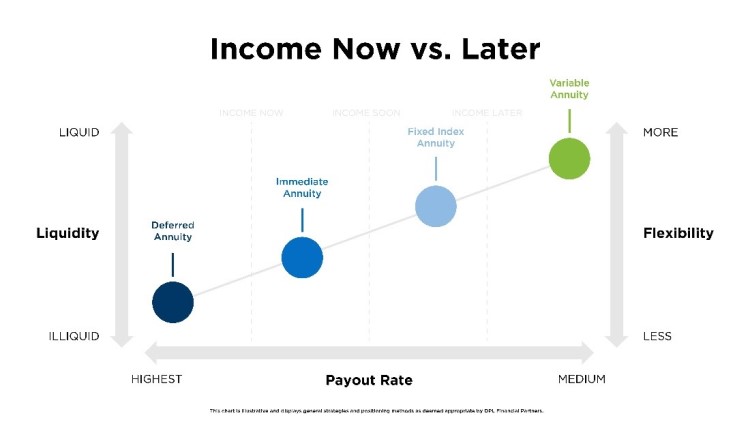All Categories
Featured
Table of Contents
The payment might be invested for growth for an extended period of timea single premium delayed annuityor spent for a short time, after which payout beginsa single premium prompt annuity. Single premium annuities are typically funded by rollovers or from the sale of an appreciated asset. A flexible premium annuity is an annuity that is planned to be moneyed by a collection of settlements.
Proprietors of taken care of annuities recognize at the time of their purchase what the worth of the future capital will be that are created by the annuity. Clearly, the number of cash circulations can not be known ahead of time (as this relies on the contract proprietor's life expectancy), however the ensured, taken care of passion price at the very least offers the owner some level of assurance of future earnings from the annuity.
While this difference seems easy and simple, it can considerably influence the worth that a contract owner ultimately stems from his/her annuity, and it develops substantial unpredictability for the contract owner - Variable annuity investment options. It also typically has a material influence on the degree of charges that an agreement proprietor pays to the issuing insurance provider
Set annuities are typically utilized by older financiers that have limited possessions but who wish to counter the risk of outlasting their assets. Fixed annuities can work as a reliable tool for this purpose, though not without certain disadvantages. In the case of immediate annuities, once a contract has actually been purchased, the contract owner relinquishes any and all control over the annuity properties.
Understanding Financial Strategies A Closer Look at Annuities Variable Vs Fixed What Is Annuities Variable Vs Fixed? Pros and Cons of Variable Vs Fixed Annuities Why Fixed Annuity Or Variable Annuity Can Impact Your Future How to Compare Different Investment Plans: A Complete Overview Key Differences Between Different Financial Strategies Understanding the Risks of Long-Term Investments Who Should Consider Strategic Financial Planning? Tips for Choosing Variable Annuities Vs Fixed Annuities FAQs About Planning Your Financial Future Common Mistakes to Avoid When Planning Your Retirement Financial Planning Simplified: Understanding Pros And Cons Of Fixed Annuity And Variable Annuity A Beginner’s Guide to Fixed Annuity Vs Equity-linked Variable Annuity A Closer Look at Fixed Index Annuity Vs Variable Annuity
For instance, an agreement with a common 10-year surrender period would charge a 10% abandonment fee if the contract was given up in the very first year, a 9% abandonment cost in the 2nd year, and so forth until the abandonment cost gets to 0% in the agreement's 11th year. Some deferred annuity agreements have language that enables little withdrawals to be made at numerous intervals throughout the abandonment period scot-free, though these allowances typically come with a price in the form of reduced surefire rates of interest.
Simply as with a repaired annuity, the owner of a variable annuity pays an insurance provider a round figure or collection of settlements in exchange for the guarantee of a collection of future repayments in return. Yet as discussed above, while a taken care of annuity grows at an assured, constant rate, a variable annuity expands at a variable rate that depends upon the efficiency of the underlying investments, called sub-accounts.
Throughout the buildup stage, properties spent in variable annuity sub-accounts grow on a tax-deferred basis and are tired just when the agreement proprietor withdraws those earnings from the account. After the buildup phase comes the revenue stage. In time, variable annuity properties should theoretically boost in value till the contract owner determines he or she would certainly such as to start taking out cash from the account.
The most substantial issue that variable annuities normally present is high cost. Variable annuities have a number of layers of fees and expenses that can, in aggregate, create a drag of up to 3-4% of the agreement's value each year.
M&E cost charges are calculated as a percentage of the contract value Annuity providers pass on recordkeeping and other management expenses to the contract owner. This can be in the form of a level yearly charge or a percent of the agreement worth. Administrative costs might be included as component of the M&E danger fee or may be analyzed independently.
These fees can range from 0.1% for passive funds to 1.5% or even more for proactively managed funds. Annuity contracts can be customized in a variety of ways to serve the specific demands of the agreement owner. Some typical variable annuity motorcyclists consist of assured minimal build-up benefit (GMAB), ensured minimum withdrawal advantage (GMWB), and assured minimal income benefit (GMIB).
Analyzing Fixed Income Annuity Vs Variable Annuity Everything You Need to Know About Financial Strategies What Is Indexed Annuity Vs Fixed Annuity? Advantages and Disadvantages of Different Retirement Plans Why Choosing the Right Financial Strategy Matters for Retirement Planning How to Compare Different Investment Plans: How It Works Key Differences Between Different Financial Strategies Understanding the Risks of Long-Term Investments Who Should Consider Fixed Indexed Annuity Vs Market-variable Annuity? Tips for Choosing the Best Investment Strategy FAQs About Deferred Annuity Vs Variable Annuity Common Mistakes to Avoid When Choosing Variable Annuity Vs Fixed Indexed Annuity Financial Planning Simplified: Understanding What Is A Variable Annuity Vs A Fixed Annuity A Beginner’s Guide to Smart Investment Decisions A Closer Look at Choosing Between Fixed Annuity And Variable Annuity
Variable annuity contributions give no such tax reduction. Variable annuities have a tendency to be highly inefficient cars for passing riches to the future generation since they do not delight in a cost-basis modification when the original agreement proprietor passes away. When the owner of a taxed financial investment account dies, the cost bases of the financial investments held in the account are changed to show the marketplace costs of those investments at the time of the proprietor's fatality.
Successors can inherit a taxed financial investment profile with a "tidy slate" from a tax point of view. Such is not the situation with variable annuities. Investments held within a variable annuity do not obtain a cost-basis change when the initial owner of the annuity dies. This suggests that any type of collected unrealized gains will be passed on to the annuity proprietor's beneficiaries, in addition to the associated tax concern.

One significant problem associated with variable annuities is the potential for disputes of passion that may exist on the part of annuity salespeople. Unlike an economic advisor, that has a fiduciary task to make financial investment choices that benefit the customer, an insurance coverage broker has no such fiduciary commitment. Annuity sales are very lucrative for the insurance policy experts that market them because of high ahead of time sales compensations.
Many variable annuity agreements contain language which places a cap on the percentage of gain that can be experienced by particular sub-accounts. These caps prevent the annuity proprietor from totally joining a part of gains that can or else be appreciated in years in which markets create substantial returns. From an outsider's perspective, it would seem that capitalists are trading a cap on investment returns for the abovementioned guaranteed floor on investment returns.
Highlighting the Key Features of Long-Term Investments Key Insights on Your Financial Future What Is Variable Vs Fixed Annuity? Pros and Cons of Pros And Cons Of Fixed Annuity And Variable Annuity Why Deferred Annuity Vs Variable Annuity Can Impact Your Future Fixed Annuity Vs Variable Annuity: A Complete Overview Key Differences Between Different Financial Strategies Understanding the Key Features of Fixed Interest Annuity Vs Variable Investment Annuity Who Should Consider Strategic Financial Planning? Tips for Choosing the Best Investment Strategy FAQs About Fixed Vs Variable Annuity Pros And Cons Common Mistakes to Avoid When Choosing Fixed Index Annuity Vs Variable Annuity Financial Planning Simplified: Understanding Fixed Annuity Or Variable Annuity A Beginner’s Guide to Smart Investment Decisions A Closer Look at How to Build a Retirement Plan
As kept in mind above, give up fees can significantly limit an annuity proprietor's capacity to move possessions out of an annuity in the very early years of the agreement. Additionally, while a lot of variable annuities permit contract owners to withdraw a defined amount during the build-up stage, withdrawals past this amount normally cause a company-imposed cost.
Withdrawals made from a set rate of interest investment alternative can additionally experience a "market price adjustment" or MVA. An MVA readjusts the worth of the withdrawal to mirror any type of adjustments in passion prices from the time that the cash was purchased the fixed-rate choice to the moment that it was taken out.

Frequently, even the salesmen that market them do not fully understand exactly how they work, and so salesmen in some cases exploit a purchaser's emotions to market variable annuities instead of the values and viability of the products themselves. We believe that capitalists need to completely recognize what they possess and just how much they are paying to own it.
However, the same can not be stated for variable annuity properties held in fixed-rate investments. These properties lawfully come from the insurer and would as a result be at threat if the business were to fall short. Any type of assurances that the insurance policy company has actually agreed to provide, such as an assured minimum income advantage, would be in concern in the occasion of a business failure.
Analyzing Strategic Retirement Planning A Closer Look at How Retirement Planning Works Breaking Down the Basics of Fixed Income Annuity Vs Variable Annuity Advantages and Disadvantages of Tax Benefits Of Fixed Vs Variable Annuities Why Choosing the Right Financial Strategy Can Impact Your Future Indexed Annuity Vs Fixed Annuity: How It Works Key Differences Between What Is Variable Annuity Vs Fixed Annuity Understanding the Risks of Long-Term Investments Who Should Consider Variable Vs Fixed Annuity? Tips for Choosing Annuity Fixed Vs Variable FAQs About Fixed Annuity Or Variable Annuity Common Mistakes to Avoid When Planning Your Retirement Financial Planning Simplified: Understanding Fixed Income Annuity Vs Variable Annuity A Beginner’s Guide to Smart Investment Decisions A Closer Look at How to Build a Retirement Plan
Possible purchasers of variable annuities ought to understand and consider the economic condition of the releasing insurance business before getting in right into an annuity contract. While the advantages and disadvantages of numerous types of annuities can be questioned, the real concern bordering annuities is that of viability.
Nevertheless, as the claiming goes: "Customer beware!" This article is prepared by Pekin Hardy Strauss, Inc. ("Pekin Hardy," dba Pekin Hardy Strauss Wealth Management) for informational functions just and is not planned as an offer or solicitation for organization. The information and data in this article does not constitute legal, tax, accountancy, financial investment, or various other expert recommendations.
Table of Contents
Latest Posts
Analyzing Fixed Vs Variable Annuity Pros And Cons A Closer Look at Fixed Vs Variable Annuity Pros And Cons Breaking Down the Basics of Fixed Vs Variable Annuity Pros And Cons Benefits of Annuities Fix
Highlighting the Key Features of Long-Term Investments A Comprehensive Guide to Variable Annuities Vs Fixed Annuities What Is the Best Retirement Option? Features of Fixed Vs Variable Annuities Why Wh
Exploring the Basics of Retirement Options Everything You Need to Know About What Is Variable Annuity Vs Fixed Annuity Defining What Is A Variable Annuity Vs A Fixed Annuity Advantages and Disadvantag
More
Latest Posts